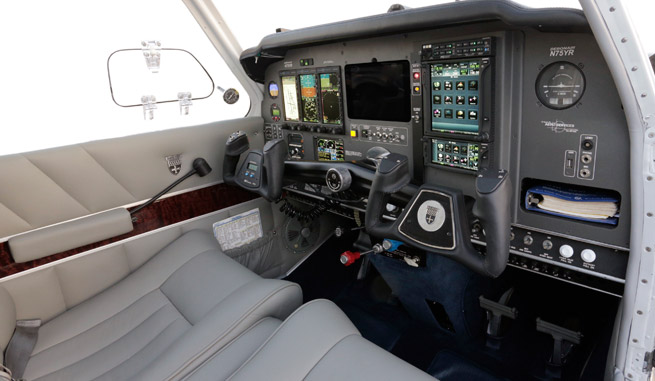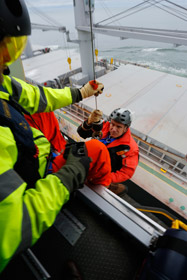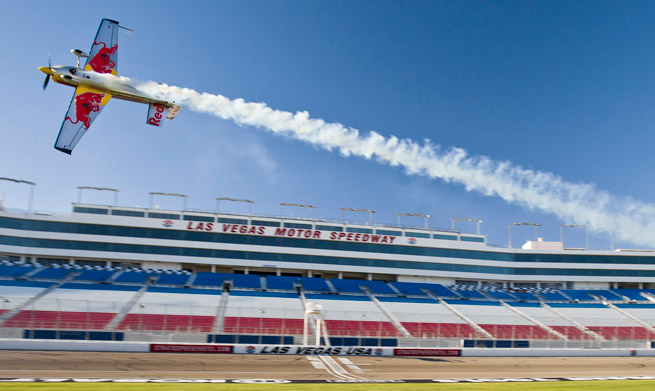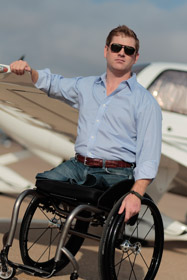Pilot Briefing: What happens in Vegas
How the Thunderbirds spent their sequestration
 Budget sequestration meant the U.S. Air Force Thunderbirds could not fly, but they could continue recruiting appearances—as long as they didn’t leave their home town of Las Vegas. (No travel money.)
Budget sequestration meant the U.S. Air Force Thunderbirds could not fly, but they could continue recruiting appearances—as long as they didn’t leave their home town of Las Vegas. (No travel money.)
Since recruiting was limited mostly to Las Vegas in 2013, could we see an Elvis impersonator one day as team boss? “I’m hoping,” said Lt. Col. Greg Moseley, commander of the 119-person U.S. Air Force Air Demonstration Squadron. “I wish I could grow out those sideburns. If I could, I think I’d be a big hit.”
Thunderbird personnel have been to Las Vegas schools so often they are on a first-name basis with some of the students. “Probably the guidance counselors and principals got to the point where they were like, ‘Will you guys please leave? You’ve been here every week!’”
Enlisted personnel ended up checking passes at the front gate of Nellis Air Force Base and conducting base housing inspections.
NOTHING TO DO: The Navy’s Blue Angels aren’t saying much about what they do when there is nothing to do, but the Pentagon provided this statement: “The Blue Angels have remained proficient by flying 11 hours a month (same as the fleet). When not conducting proficiency flights, the team has participated in various community outreach activities. However, the team’s participation in these outreach activities ceased as of October 1 based on guidance from the Office of the Secretary of Defense stating that all departmental community and public outreach activities will cease.”
All members of the U.S. Air Force Aerial Demonstration Team were encouraged to take classes. Most were aimed at career advancement. Thunderbird 5, lead solo pilot Maj. Blaine Jones, who has a master’s degree in bakery science and management—the family business he left to join the Air Force—attended Air Command and Staff College: www.youtube.com/watch?v=lCafWKnIyyg
Debonair Sweepstakes: Leather and glass
Putting both in action
By Thomas A. Horne

After flying the Debonair with its funky old interior for more than a year, it was a relief to experience the airplane’s much-needed overhaul. Ohio’s Clermont County Airport-based Air Mod did the work and it’s a sight to behold. Air Mod has done several of AOPA’s sweepstakes interior renovations—each one a beauty, and this one’s no exception. Ergonomically correct leather seats with lumbar support are the first things you notice, and the most important in making even super-long flights the most comfortable they can be. The added touches are nice, too. Things such as storage pockets and a large compartment for holding charts, iPads, flashlights, notes, and other necessities. Air Mod’s Dennis Wolter went an extra step and added vintage Beechcraft logo shields (with the big Beechcraft “B”) to the side panels.
A lot of Air Mod’s best work isn’t visible. It’s the extensive internal cleanup and anti-corrosion measures. This is documented pretty well in my “Sweepstakes Logbook” blog entries, where the photos show an ugly belly with inch-deep geological layers of dirt transformed into gleaming aluminum, which is then coated with zinc chromate for long life. Luckily for us, there was no corrosion. But if there had been, it would have been eliminated. “Now the airplane is good for another 30 years,” Wolter says of his anti-corrosion work.
I was pumped for the 730-nm trip from Clermont County to AOPA Summit in Fort Worth, Texas. The airplane was filled to the gills with 120 gallons of fuel—more than enough for what would be a five-hour, 11-minute nonstop journey.
It was during the runup that it happened. The Aspen primary flight display (PFD) came up with two red Xs. For some reason the screen had died. A quick scan of the cockpit showed no breakers popped or anything else untoward. I stared in disbelief at the Xs. After the shock wore off, I figured it out. The Aspen Evolution system in the Debonair consists of two multifunction displays (MFDs) and a PFD—three screens in all. And the PFD and rightmost MFD have attitude and heading reference systems (AHRS) of their own. So the solution was to push the red Rev button on the MFD. This puts the right MFD in reversionary mode, and up came the attitude and heading information. I was good to go.
After takeoff, I was even able to link the S-Tec System 50 autopilot to the MFD. You simply move the centrally mounted Autopilot Source toggle switch to the MFD Rev position. Now the autopilot has all it needs for heading, altitude hold, and nav tracking functions. It was as though I never lost any capability. This was another neat feature of the Aspen installation, as well as the panel architecture designed by Santa Fe Aero Services, the avionics shop that made the Deb’s new panel. By the end of the day, Aspen responded to the problem by replacing the faulty PFD.
At AOPA Summit, it was time for visiting members to get a look at the new interior for themselves. The most frequently heard comment? “Man, get a load of that new-car smell!”
Email [email protected]
Three ways to win one of 76 prizes in AOPA’s Debonair Sweepstakes
Join or renew your AOPA membership and you will be entered to win in AOPA’s Debonair Sweepstakes. AOPA is giving away a completely restored 1963 Beechcraft Debonair B33 with an all-new ergonomic interior, the latest avionics, and an up-to-date airframe as the grand prize. Plus, you could also win one of 75 other great aviation prizes. Visit the website for ways to enter.
Winch a sea captain, mug a buffalo
For more variety in your aviation job choice, see Brim Aviation
By Alton K. Marsh
 Imagine yourself a helicopter pilot—unless you are one of 14,264 AOPA members who already fly them. Next, imagine you are going to pick up a ship captain on a hoist but with your rotor blades 10 feet from the ship structure. Now, imagine doing that at night.
Imagine yourself a helicopter pilot—unless you are one of 14,264 AOPA members who already fly them. Next, imagine you are going to pick up a ship captain on a hoist but with your rotor blades 10 feet from the ship structure. Now, imagine doing that at night.
Pilots of Brim Aviation in Astoria, Oregon, not only do that at night, they do it up to 17 times in one night. Ships need specialized captains to pilot them across the four-mile-wide Columbia River Bar—a nasty obstacle of boiling water that has claimed 400 ocean-going ships since 1794—2,000 if you count the small boats, too. It’s where the Columbia River shoots like a bullet into the Pacific Ocean, unfettered by the deltas that slow and calm the Mississippi River where it meets the Gulf of Mexico. A helicopter like Brim’s new twin-engine AgustaWestland 109SP is the best way for captains with special knowledge of the bar to meet arriving ships or depart from outbounders—especially when waves are 15 to 20 feet. Ten-foot waves equal, “a nice summer day for us,” said Gene Hill, Brim’s chief pilot.
Brim’s crews are good at what they do. It was only 28 seconds from the time the Agusta began its hover above the deck of a bulker—a ship with cargo cranes that must be avoided by the helo pilot—and the time the captain’s head appeared above the floor level of the cabin. During that time the hook was lowered, the captain attached, and the hoist completed.
Crews make the trip 2,500 times a year, Brim said. “If there was a road dug in the sea, we would have a 20-foot rut in it,” said hoist operator Russ Scheel. “We do it the same way every time.”
The company was started by Burl Brim, owner of a Cirrus SR22, and has branches in Texas and Arizona with headquarters in Ashland, Oregon.
In winter Brim crews using MD500 and MD600N helicopters to catch bison in the Henry Mountains of south-central Utah. A Brim crewmember shoots them with a gun that fires a net and another Brim employee—a “mugger”—wrestles it to the ground to take blood and tissue samples. The buffalo are fitted with a transmitter broadcasting a GPS position that lasts two years.
Brim crews do other interesting things, like setting fire to the old armament ranges of Fort Ord (closed in 1994) at Monterey Bay, California, to expose unexploded ordinance. They rescue boaters from the Oregon River in southern Oregon, and train the Beijing police in search and rescue. But those are stories for another day.
Fly along with us in this online video.
Email [email protected]
Agusta comes well equipped
Brim’s AgustaWestland 109SP comes equipped with enhanced vision by Max-Viz, a four-axis autohover autopilot from Sagem Avionics, and the Cobham FlightLogic terrain display. Brim pilots do not autohover beside ships. There are dual GPS, VOR, and ILS navigation receivers as well as an air data attitude and heading reference system (ADAHRS). While ships automatically transmit a GPS location, the helicopters use Honeywell RDR 2000 weather radars to find the ships. Occasionally they land on ships.
Talking past the language barrier
Since 99 percent of ships arriving at Astoria, Oregon, are foreign, helicopter pilots taking channel pilots to them keep communication simple. “We’ll say, ‘Please open all deck lights,’ followed by, ‘Open all in-port lighting,’” said Brim Chief Pilot Gene Hill. “Open lights means different things in different cultures. With our Russian ships, open all lights means you open the switches, which turns them off.”
Want the job?
You need to have a commercial helicopter certificate, Brim Aviation founder Burl Brim said. You also need instrument and multi-engine ratings. “I prefer to have pilots that have 2,500 hours or more. This is a tough job. Tough conditions. Lot of weather. Instrument conditions. It’s more instrument flying than it is VFR flying, especially at night. When you take off to go offshore at night, you’re flying into a black hole.”
Scheduled service in a Cirrus
Charter operators connecting New York and Boston
By Jim Moore
A pair of Boston- and New York-area charter operators have teamed up to form Linear Air, a scheduled (Part 135) service using Cirrus SR22 aircraft. The routes, which connect Westchester County Airport in White Plains, New York, to either Hanscom Field in Bedford, Massachusetts, or Boston’s Logan International Airport, are priced to compete with “walk-up” airline fares (typically less than seven days advance booking)—with the added bonus of skipping security lines and congested airports. The charters offer conveniences such as having the flight department also arrange ground transportation as needed.
Linear Air’s first scheduled flight launched in October from White Plains to Logan. Linear Air handles the scheduling side of the operation, and Hopscotch Air operates a small fleet of Cirrus SR22s. Both hope to fill seats by departing from the traditional charter pricing model. Seats cost $775 on flights to Bedford and $875 on flights to Logan, regardless of actual travel time.
“We’re very evangelical, if you will, on the issue of fixed pricing,” said Hopscotch Air CEO Andrew Schmertz. “We think it’s important that the industry move to this model.”
Linear Air is working with online travel booking site Kayak to gain a foothold in the booking system used by airlines. Finding these new flights via Kayak requires a little digging—Kayak considers the SR22 a “turboprop,” for example—although Linear Air has created an easy-access portal to find the new scheduled flights quickly.
Linear Air Chief Operating Officer Peter Schmidt said the company has also forged a partnership with Skyway Air Taxi serving the Washington, D.C., area, and plans to establish partnerships with similar qualified operators around the country. In time, customers will be able to book a Cirrus (or a business jet) seat with the same system used to fill airlines. Schmidt said potential partners include about 50 operators with Cirrus aircraft already offering air taxi service under Part 135 certificates. “We’re planning to build a network across the United States.”
“A lot of people aren’t aware of what private aircraft can do,” Schmidt said. “That is the single biggest challenge that we plan to overcome.”
Schmertz said customer preferences on airports and times may lead to adjusting schedules. (Both companies continue to offer traditional charter and air taxi services as well.) Schmertz said the service—scheduled or otherwise—may help boost the pilot population, along with demand for GA aircraft. Two nonpilot air taxi customers have already purchased Cirrus aircraft of their own, Schmertz said, noting his company also has partnered with Cirrus to provide pilots and flight department services to nonpilot Cirrus customers. Getting an up-close look at the sophisticated avionics, and having an hour or more to chat with the pilot, can make GA buyers out of many customers, Schmertz hopes.
“Nobody is getting on an Airbus and at the end of the flight saying, ‘I want to buy one of these,’” Schmertz said.
Email [email protected]
First of its kind: GPS wristwatch
Garmin’s new D2 is big enough to appeal to any fighter pilot or rapper
By Dave Hirschman
 This first-of-its-kind GPS wristwatch (retail price $449) has some innovative and potentially helpful features. The Direct-to button constantly updates time and distance calculations to any airport destination; the Nearest button finds the closest airports; and vibrating altitude alerts can provide tactile sensations that warn pilots of unwanted changes. The D2 can share flight plans with the Garmin Pilot app, and the watch can remotely turn Garmin’s VIRB action camera on and off. It’s also slick that the D2 knows what time it is as soon as it gets a view of the sky, so it always knows what time zone it’s in.
This first-of-its-kind GPS wristwatch (retail price $449) has some innovative and potentially helpful features. The Direct-to button constantly updates time and distance calculations to any airport destination; the Nearest button finds the closest airports; and vibrating altitude alerts can provide tactile sensations that warn pilots of unwanted changes. The D2 can share flight plans with the Garmin Pilot app, and the watch can remotely turn Garmin’s VIRB action camera on and off. It’s also slick that the D2 knows what time it is as soon as it gets a view of the sky, so it always knows what time zone it’s in.
The D2’s monochrome display lacks contrast and can be difficult to read in direct sunlight. The watch face is huge, but small numbers aren’t always easy to make out. (Garmin recommends turning the contrast up to 100 percent and customizing the pages to show fewer, larger fields.) The lack of readability makes the watch’s moving map and horizontal situation indicator less useful than they would otherwise be.
The D2 has a built-in altimeter that shows barometric (not GPS) altitude, and it’s remarkably accurate. The first time I saw it in action was leaving Dallas on a Southwest Airlines 737, and I was sure the watch was broken because it showed a paltry climb of 200 fpm to 8,000 feet, when in fact we were going up 10 times that fast all the way to 39,000 feet. Of course, the watch was showing cabin altitude, not the height of the airplane above sea level. At my home airport with the barometric pressure properly adjusted, the watch’s altitude display was spot on.
The lithium-ion battery must be recharged regularly, and recharging can only be done with a power cable unique to the watch (not a USB connection). Theoretically, the D2 battery can last up to 50 hours in GPS mode and up to five weeks in watch mode, so it shouldn’t need charging on most out-of-town trips. Garmin’s D2 is a novel gadget and interesting conversation piece. Wearing it around AOPA headquarters draws lots of attention, and everyone, it seems, wants to get their mitts on it.
The D2 can be a potentially life-saving navigator of last resort; warn of altitude or pressurization changes; keep pilots from getting lost on VFR trips; and answer when-are-we-going-to-get-there questions at a glance. Whether pilots choose to use it as a serious tool or a curious novelty will be up to them.
Email [email protected]
Red Bull Air Race returns
Seven venues featuring popular pilots
By Alyssa Miller

Red Bull’s three-year hiatus was to reorganize, “strengthen development and commercial aspects of the race.” While the company was retooling its air race business and setting up 2014 locations, the pilots weren’t resting on their laurels. Many continued to perform at airshows, some returned to other types of flying (Paul Bonhomme resumed flying Boeing 747s), and they focused on staying in shape physically in hopes of the return of the rigorous Red Bull Air Race.
“I’ve missed the flying in the Red Bull Air Race because the competitive racing is just fantastic for the pilots,” said Bonhomme, the 2009 and 2010 world champion.
U.S. pilots Michael Goulian and Kirby Chambliss are returning to the lineup. Red Bull said Chambliss “is one of the most consistently successful pilots in the history of the Red Bull Air Race.” Chambliss has two world championships and eight race wins under his belt.
In addition to Bonhomme, Goulian, and Chambliss, other pilots on the 2014 roster are Hannes Arch, Peter Besenyei, Martin Sonka, Nicolas Ivanoff, Matt Hall, Nigel Lamb, Yoshihide Muroya, Matthias Dolderer, and Pete McLeod.
The 2014 season kicks off March 1 in Abu Dhabi and runs through November where it ends in China. Other stops include Putrajaya, Malaysia; Gdynia, Poland; Ascot, United Kingdom; the Texas Motor Speedway near Dallas; and the Las Vegas Motor Speedway. Ticket information is not available for all locations, but Red Bull said tickets were available for Dallas/Fort Worth, Ascot, and Putrajaya November 1 and China starting December 1 (although a venue has yet to be announced). Venues outside the United States will be similar to those used in the previous races, including over-water sites.
Email [email protected]
Wounded veteran earns wings
First recipient of AOPA scholarship
By Sarah Deener
 On the ground, there are limitations. But in the air, Andrew Kinard finds total freedom. “Flying to me is the ultimate expression of freedom,” says Kinard, who lost both legs above the knee in an improvised explosive device (IED) blast in Iraq in 2006. The retired Marine first lieutenant, now in his final semester at Harvard Business School, earned his sport pilot certificate with an AOPA-Able Flight scholarship this summer. He encounters obstacles like stairs and curbs in his wheelchair, “but up in the air there’s nothing that gets in my way. I can go anywhere I want to.”
On the ground, there are limitations. But in the air, Andrew Kinard finds total freedom. “Flying to me is the ultimate expression of freedom,” says Kinard, who lost both legs above the knee in an improvised explosive device (IED) blast in Iraq in 2006. The retired Marine first lieutenant, now in his final semester at Harvard Business School, earned his sport pilot certificate with an AOPA-Able Flight scholarship this summer. He encounters obstacles like stairs and curbs in his wheelchair, “but up in the air there’s nothing that gets in my way. I can go anywhere I want to.”
Kinard, a graduate of the Naval Academy, passed up a Marine aviator’s slot to lead ground troops in the infantry. He deployed to Iraq in 2006 as a platoon commander, and during the deployment was critically wounded by an IED. He has since gone through more than 79 surgeries. During his recovery, Kinard traveled to Purdue University for training offered in partnership with Able Flight, which offers flight training opportunities to people with physical disabilities.
About a quarter of the scholarships in the Able Flight program are allotted to wounded veterans, according to Executive Director Charles Stites. Able Flight has received a grant from the nonprofit veteran service organization Wounded Warrior Project for $45,000, which will support five new scholarships for veterans wounded in service since September 11, 2001.
“I love rising to a challenge, and flying is certainly a challenge,” Kinard said. “Every day is different. There are external factors like traffic and weather that really make flying a pleasure when you meet those challenges.”
Fly with Andrew Kinard in the online video. Donations to support the AOPA-Able Flight scholarship may be made through the AOPA Foundation (www.aopafoundation.org).

